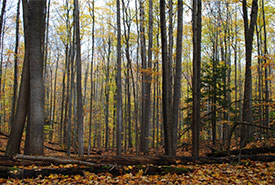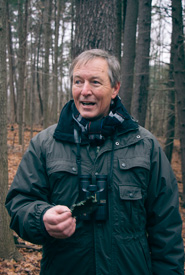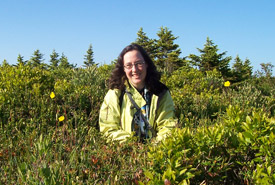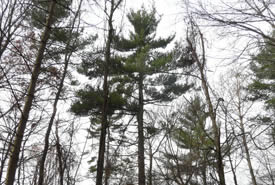Forest champions

Happy Valley Forest (Photo by NCC)
In 1971, Dr. Seuss gave us The Lorax, a cautionary tale about realizing the value of trees only when we’ve chopped the last one down. It’s a story that, despite successes in forest conservation, is as relevant today as it was 45 years ago. The four forest champions profiled here who defend the trees, indeed speak for them, relish the progress made but still see plenty of work ahead. And all insist that the trees have plenty to tell us…if we’ll listen.
Mark Stabb
Central Ontario Program Director, Nature Conservancy of Canada
If he hugged a tree it would be an old one. Mark Stabb has spent much of his career fighting to save old-growth trees. To him, the 200-year-old beech, the 300-year-old maple, the 600-year-old hemlock aren’t just long-standing pillars of wood; they’re totems of inspiration that should give us all pause.

Mark Stabb talking to students about MacMillan Nature Preserve while they explore the property. (Photo by Alexandra Ouzounis)
“Big trees kinda put you in your place and time; your place on the planet, and remind us of how short a time we have compared to those big, old trees.”
Mark Stabb’s number one job involves managing conservation real estate deals — acquiring significant and sensitive habitats through land donations, purchases and other means. Then he oversees field staff who care for these properties. One of the perks is that he then gets to lead hikes on the lands he helped to protect. One of his favourite spots is the Happy Valley Forest, north of Toronto, one of NCC’s projects. He relishes the role he plays, introducing people to these “great old forests,” and he routinely encourages the hikers in his groups to,
literally, hug a tree.
“People don’t seem to have the time to develop relationships with trees that maybe they did in the past. Sometimes you have to encourage people to pause along trails a bit and not just walk under the canopy. There’s nothing like touching the bark of a tree and then stretching your head back to look up the tall trunk and appreciate the architecture of the branches, the symmetry, the diversity…”
Up until a few decades ago, dead trees, says Stabb, were generally considered flawed parts of the forest, “which is completely incorrect.” He was the first researcher to study the southern flying squirrel in Ontario, considered a rare species, and revealed how it relies on the cavities of dead trees. Dead trees, he says, “are meant to be there.”
Suzanne Simard
Professor of Forest Ecology, University of British Columbia, Vancouver

Suzanne Simard (Photo courtesy Suzanne Simard)
Trees really do communicate, says Suzanne Simard, who’s on the forefront of groundbreaking research into plant messaging. “When you look at the networks, the kind of communication that goes on and the layout of those networks, what they look like physically… is very much like a neural network. And so it’s easy then to say that if it’s physically structured and there are certain common features of cells for the movement of chemicals across membranes that are common to brain cells and fungal cells and all cells…then it’s an intelligent hypothesis to look and see if trees are communicating in a similar way.”
The Bill & Melinda Gates Foundation is so intrigued, that Simard was recently invited to present what she knows about plant communication. “We know, based on this research, that these plants are connected and communicating below ground and above ground and they’re in touch with each other. They’re saying things like, ‘How are you?’ ‘Do you need help?’"
The biggest and oldest trees are the most highly connected, says Simard, so researchers have taken to calling them what many older cultures do — mother or grandmother or elder trees.
“Some of our latest research is looking at when mother trees are injured or dying. They send lots of their resources — I’ve been calling it wisdom — to understory seedlings, which increases their resilience,” says Simard.
Paula Noël
New Brunswick Program Director, Nature Conservancy of Canada
Paula Noël was just a kid when she heard about a local body of water that was declared dead. She was confused, she says — “I remember it striking me: how does a stream die?” — but it helped her understand the impact that humans were having on the environment and sparked a desire to help.

Paula Noël, program manager New Brunswick (Photo by NCC)
Noël is lucky to work in an NCC office in Fredericton across the street from Odell Park, which contains an old-growth eastern hemlock forest. Noël’s routine often includes a lunchtime walk along the park’s trails; a 45-minute circuit that, she says, is energizing.
“It’s just such a huge difference to my mood and my energy and how productive I can be. “It puts you in your place in the universe,” she says, “and puts everything into perspective. Suddenly the little things that you stress out about every day don’t seem as important.”
Her favourite tree species? Eastern white cedar. “When you find an old stand of cedar, they get quite enormous and often have this mossy emerald green undergrowth. Cedar grows well on rich, calcareous soil and rare plants frequently grow in cedar swamps. When you find a stand of cedar like that, there’s something magical about them.”
Using satellite imagery, Noël and her staff have been identifying old stands of Acadian forest, which are increasingly rare in New Brunswick. They then reach out to the landowners to speak with them about conserving them. “There are many rewarding things about working [for NCC],” says Noël. “But that is always one of the best for me, when you make a cold call or send out this letter to a total stranger, and then you find a kindred spirit who’s just as interested in saving the trees as you are."
Peter Quinby
Chair and Chief Scientist, Ancient Forest Exploration and Research, Chisholm Township, Ontario
Peter Quinby was just six months old when his parents packed him up for the trip to the family cottage on Smoke Lake in Algonquin Park. His summers were spent learning the names of birds and plants and savouring the outdoors. He devoted his education to forest ecology and remains awed by the resilience of trees.
“I don’t think that’s reason to continue to take too much from the forest but I do think that’s good reason to be optimistic about being able to restore areas where we have taken too much and where we have abused nature...It’s heartening to see how they can bounce back,” he says.

White Pine (Photo by Bernt Solymar)
Quinby has been working since the 1980s to protect the old trees, noting that there was virtually no research into old-growth forests in eastern Canada until he began working on the concept. Partnering with the Temagami Wilderness Society (now known as Earthroots) and highlighting data that showed that the red and white pine forests were an endangered ecosystem helped inspire the protests and the media attention that led to its protection and an increase in protected areas of red- and white-pine in Ontario from 6,000 hectares (15,000 acres) in 1988 to 100,000 hectares (247,105 acres) in 2000. “I’m proud of that,” says Quinby.
Quinby worries about the increasing pests that are invading forests, particularly the hemlock wolly adelgid and beech-bark disease. “I have seen forests decimated by pests,” he says, noting that a key role of small NGOs is to put pressure on forest conservation agencies to be preventive. “We need to get out in front of these things,” he says.
This story was written by Leslie Garrett and originally appeared in the Fall 2016 issue of the Nature Conservancy of Canada Magazine. To learn more about how you can receive the magazine, click here.




